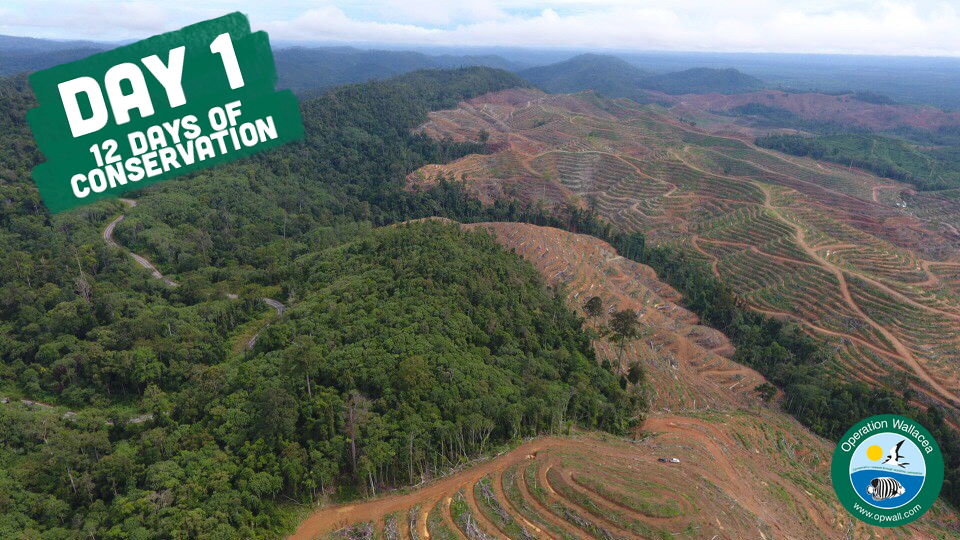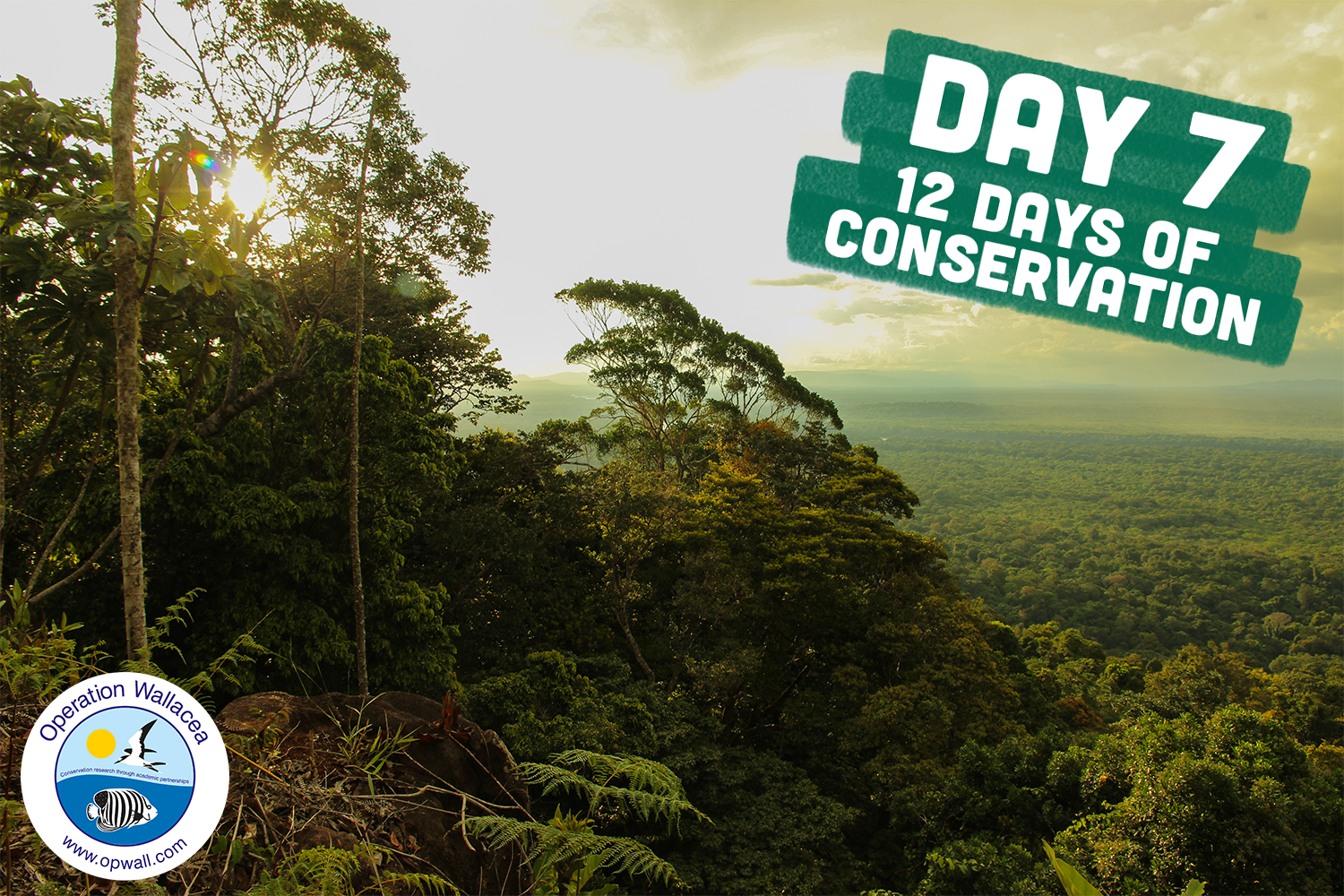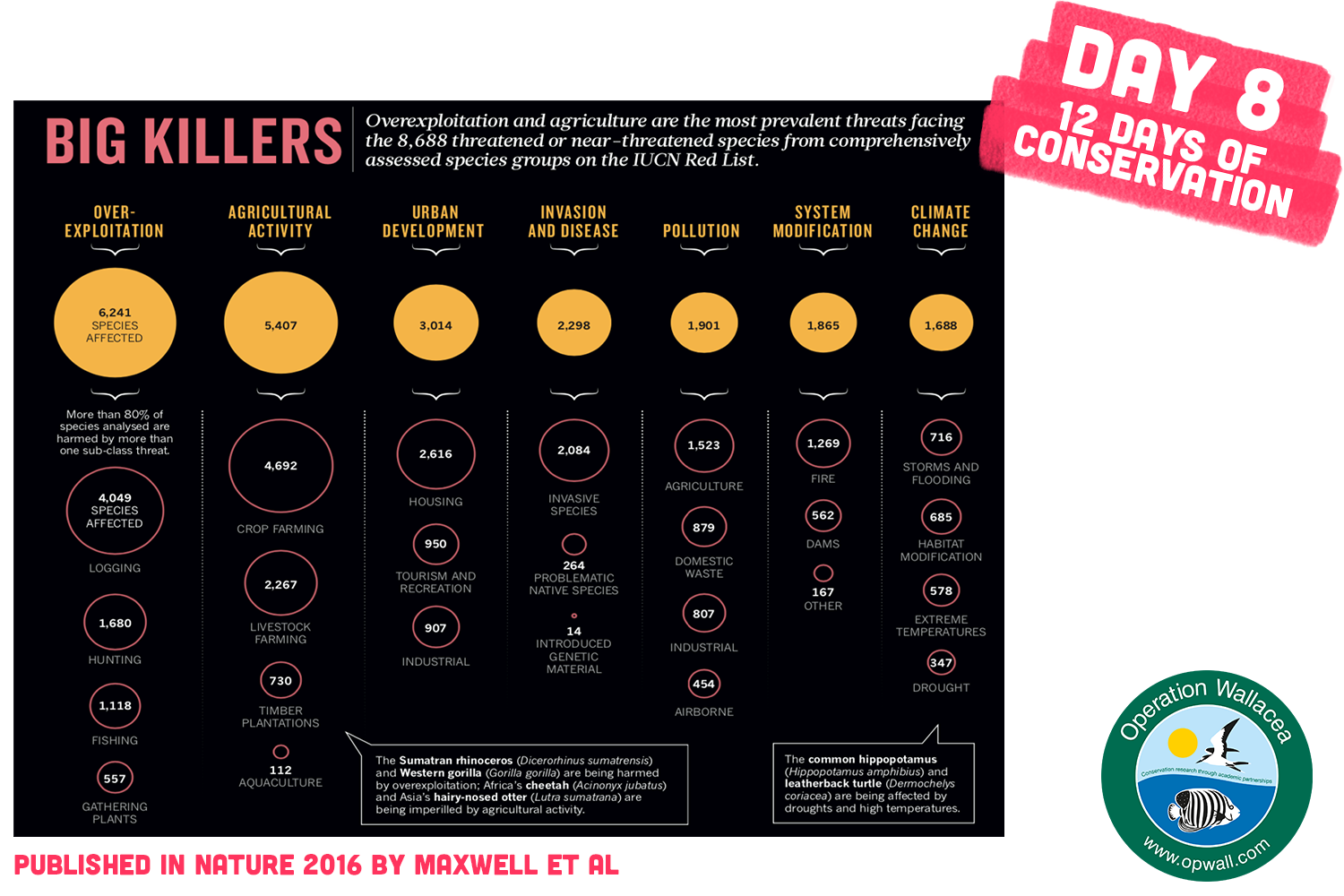

Day 1: Pushing back against oil palm in Borneo!
Day 2: Overhunting in Honduras Cloud Forests
Day 3: Climate Change’s Impact on Wildlife in Mexico!
Day 4: Cute but Deadly
Day 5: Deforestation in Sulawesi
Day 6: Is (all) flying bad for the environment?
Day 7: Can a $10 per tonne carbon tax on flights offset emissions?s
Day 8: Climate change is NOT(?) the main driver of species extinctions
Day 9: Near extinction for the Imperial Parrot
Day 10: Changing rainfall patterns in the Amazon
Day 11: Controlling Invasive Lionfish in the Caribbean
Day 12: Growing Ecotourism in Madagascar

Over the last 40 years in Borneo, over 30% of the remaining forests have been felled. In East Kalimantan, the government stepped into prevent 13,000ha of primary lowland forests in Borneo being converted into oil palm.
The Lesan Conservation forests were been created to provide a refuge for species such as orangutan, clouded leopard and sun bear. The idea behind this was to provide an area where visitors could see rainforest species; but the Lesan forests are surrounded on their north, east and south borders by oil palm.
The western side still has intact forest that links to the wider forests on the steep slopes of the surrounding mountains. If this western edge can be protected then the Lesan forest can remain an important refuge for lowland species, but there is a significant threat from the oil palm growers to extend their plantataions to this western boundary.
Over a 6 week period in summer 2019, Opwall teams took around 200 students and scientists to conduct biodiversity surveys and the government has now committed to protecting the western boundary of the forest because they can see the potential income to local communities from ecotourism.

Mesoamerican cloud forests are unique ecosystems which support extremely high biodiversity, but they tend to be small and highly fragmented. This means that populations of large mammals that inhabit tend to be have small numbers and are very vulnerable to unsustainable hunting pressures.
In Cusuco National Park, Honduras, species such as Baird’s Tapir and Jaguar have been pushed to the brink of extinction by such hunting and only a handful of individuals of both species are now likely to persist here.
Data from the Opwall survey teams in Cusuco suggests that the presence of volunteer-driven conservation projects is an effective deterrent to illegal hunting, along with the establishment of community ranger patrols.
Panthera, a wild cat conservation charity, hid a series of recording devices across the park and measured the number of incidences of illegal hunting each month. During the 2 months when Opwall teams were on site there were 0 recorded incidences of illegal hunting and for the additional 4 months where Opwall funds the rangers in the park there were only 4 incidences. Over the other 6 months of the year however, there were over 80 recorded incidences of illegal hunting.
Take home message: volunteer conservation and funding rangers really works 👍

Climate change is not just affecting temperatures but also having a big impact on rainfall patterns. Opwall teams in the Calakmul forest, Mexico, have been running a huge camera trapping project and have seen some BIG changes.
The bedrock of the forests are karst limestone so when it rains most of the water runs into underground rivers that are inaccessible to wildlife. The only surface water is in aguadas – low lying areas clogged with mud and leaves. The northern areas of the Calakmul forests are drier than the southern areas, which spread over the border into Guatemala.
Over the last few years there has been an extended drought and the aguadas in the north of the forest have dried up. If you are a peccary (New World pig) you can’t survive without wallowing in mud so the peccary populations have moved south; and they’ve been followed by their main predator – jaguars.
The jaguars following the peccary south means that they are getting closer to farming areas and started preying on livestock so there is now conflict between the farmers and the jaguars – an unexpected impact of climate change

The Small Indian Mongoose was introduced into Fiji to control snakes, particularly in the sugar plantations. Unfortunately, not only has the mongoose controlled the snakes it has also had a catastrophic impact on a range of other native species including lizards, amphibians, ground birds such as the Long-legged Warbler and Shy Ground Dove and some of the large endemic land snails in Fiji. This is an example of where an introduced species has had a CATASTROPHIC impact on species survival!
Opwall teams are working in a remote peninsula on Vanua Levu and have discovered: ✔️ A species of Swallowtail butterfly completely new to science ✔️ Good populations of the Natewa Silktail – an endemic bird found only on the peninsula ✔️ 3 other endemic Vanua Levu birds ✔️11 island endemic tree species ✔️Numerous other island endemics
The plans with the local communities now are to establish a new national park and to reduce populations of these cute but deadly invaders.

Indonesian forests are being lost at an alarming rate – around 2% per year in SE Sulawesi where Opwall teams work As part of Norway’s drive to become carbon neutral, they invested $1 billion in the Indonesian forestry department to incentivise them to stop deforestation and to provide compensation payments to local communities who are suffering the loss of potential income by not deforesting. This funding is known as REDD+ and could be a major way for developed countries to help slow deforestation. Sulawesi has many endemic species because it is in the Wallacea region; a group of islands that remained isolated from the Asian and Australian continents throughout the Ice Ages. Since Opwall teams started researching in Sulawesi we have discovered 21 vertebrate species new to science from one island. If the REDD+ scheme is going to target anywhere then these endemic, rich forests should be top of the list!

The argument often heard is that the carbon emissions from flying are having a negative impact on the environment – and this is completely true! Another threat facing the natural world is that over-exploitation (deforestation/over-hunting/over-fishing) is driving species loss
Establishing protected areas is ESSENTIAL for saving species. However, for these solutions to be sustainable, local communities who suffer the loss of not being able to clear land for agriculture or hunt certain species must have another way to financially benefit.
Opwall and other organisation’s community-based wildlife ecotourism can have a huge impact on how local communities view their forests. In Fiji, for example, over 3 years approx. 500 students have helped with a biodiversity mapping project. From rapid deforestation there is now unanimous agreement between all the local communities to create a new national park. Additionally, at the Opwall site in Borneo, visits from less than 200 Opwall students has delayed the imminent isolation of an area of lowland forest because the local communities can see the economic benefits of wildlife tourism.
Although flying has negative environmental impacts, not flying could have the opposite impact on species survival than widely thought. Flying for the right reason – to fund protected areas and conduct conservation research – could help tackle over-exploitation

While flying to participate in wildlife ecotourism is beneficial to species survival, most people who fly are not heading out to help in this way. In 2019, a study in Science showed that by reforesting 0.9 billion ha of underutilised land (most of it in the Tropics) the trees planted could store 205 gigatons of carbon. Since the Industrial Revolution, Man has added 305 gigatons of carbon to the atmosphere, so by planting up this area, the amount of carbon in the atmosphere could be massively reduced. Flying is responsible for 2% of all carbon emissions and adds 895 million tonnes per year. Therefore, to offset the emissions of the aviation industry we would need to reforest 2% of the 0.9 billion hectares (approx 18 million hectares). Opwall is trialling a 300ha project where small, rural farmers in Indonesia who have land next to existing forests, are being paid to plant native rainforest trees on their land and are paid annually to maintain them as they grow. After 20 years, the farmers will be permitted to harvest 5% of the trees each year and continue getting the annual payments as long as they replant the trees they fell. If the costs of schemes like this are kept at less than $495 per ha per year then the whole 18 million ha could be reforested for a $10 per tonne charge paid by each air passenger.

At Opwall we’re very impressed with how Extinction Rebellion has raised the profile of climate change as a major threat facing the earth and that we are heading towards the 6th major extinction since life started on earth due to Man’s actions. These are both major issues and shining a light on them has helped with publicity for the global biodiversity crisis. However, if we only reversed the effects of climate change it would, unfortunately, have little impact on the rate of species extinctions.
Maxwell et. al. published a paper in Nature in 2016 looking at the 8688 endangered or critically endangered species on the IUCN list and identified what is pushing these species towards extinction. The number 1 reason by far (72% of cases) was over exploitation – deforestation, over-hunting or over-fishing. The second was agriculture, followed by urban development, invasive species and disease, pollution and system change and climate change. And of course, these issues intertwine with each other, such as deforestation removing trees that would have otherwise stored carbon.
So yes, climate change is a very important issue, but we must be careful not to narrow our focus and forget about the other threats facing biodiversity

The Imperial Amazon Parrot (Amazona imperialis,) is only found on the Caribbean island of Dominica, where it is the National Bird, appearing on both the country’s coat of arms and flag. Unfortunately, it is one of the most endangered parrot species in the World.
Imperial Amazon (A.K.A. Sisserou) populations, which have never been large, were extremely badly affected by Hurricane Maria – a Category 5 storm which struck the island in September 2017, destroying most the species’ available habitat.
The Imperial Amazon parrot’s status was changed from Endangered to Critically Endangered in the latest IUCN Redlist update – a decision that was partially based on field data collected by Opwall scientists and volunteers.
It is likely that the population of A. imperialis is now <50 adult birds, with only a handful of individuals being held in captivity. Carefully planned conservation interventions are now VITAL to ensure the species does not become extinct in the near future

When you think of the effects of climate change you may not immediately think adding an extra degree of temperature in the Amazon would make that much difference to the wildlife. However, there are substantial impacts of climate change here, mainly due to changing rainfall patterns in the Andes Mountains.
At the Opwall Amazon site in Peru, our teams have been monitoring how water level changes are impacting the species. In a normal year, the Amazon in this area rises about 10m from the end of the dry season to the end of the wet season. That means the river floods out across the forests. In one of the study areas between two river systems, the river covers 92% of the forest! That means if you are a peccary or a Brocket deer you are squeezed into just 8% of the land; the same 8% as all your predators😱
In 2015 water levels were significantly higher and 95% of the forest was flooded which means predation on the peccaries and Brocket Deer intensified more, and populations crashed. The impact of these changing water levels was reported to one of the United Nations Climate Change Convention’s COP meeting held in Lima.

An attractive looking species that is having a deadly impact on its environment; the Lionfish. This species is native to the Indo-Pacific but is commonly collected for aquariums and was accidentally released in waters off Florida a few years ago
Lionfish have now spread across the whole of the Caribbean and since they don’t have any natural predators in that part of the world, they have built up HUGE populations that are having a big impact on the ecology of the reefs
Local communities across the Caribbean are putting a lot of effort into spear fishing as many of these invasive lionfish as possible (plus they provide a tasty meal). However, the life cycle of lionfish is that the eggs float, fry (young) inhabit seagrass and mangroves and as they grow larger, the lionfish gradually move deeper and deeper; the largest fish living below 100m. Spear fishing is only targeting teenagers in the lionfish population because larger individuals are well beyond diving depths.
In 2019 the Opwall Honduras team trialled a semi-autonomous robot with image recognition of lionfish that could control populations at these large depths

Deforestation in Madagascar is as extreme as seen anywhere in the world. The drive from Antananarivo to the Opwall study sites in northwest Madagascar takes a day and a half and through mile after mile of deforested and unused land.
The Madagascar government has a target of gazetting 10% of their land as national parks, building on the 3% that was already protected in 2003. More national parks have been created since this target was set, but the best hope for Madagascar wildlife is with community management of the forests, which could cover much greater areas.
Opwall teams are mapping the wildlife in areas of community managed dry forests in the north west of the country, which are turning out to be exceptionally biodiverse. The purpose of the Opwall programme in Madagascar is to help the local communities build ecotourism businesses, so that travellers who wish to see the special fauna of Madagascar dry forests head to Mariarano.
Local communities need income from sources like ecotourism if they are going to protect their wildlife
If you would like to hear more about Operation Wallacea, our conservation work and how you could get involved, follow these links:
Social Media Links